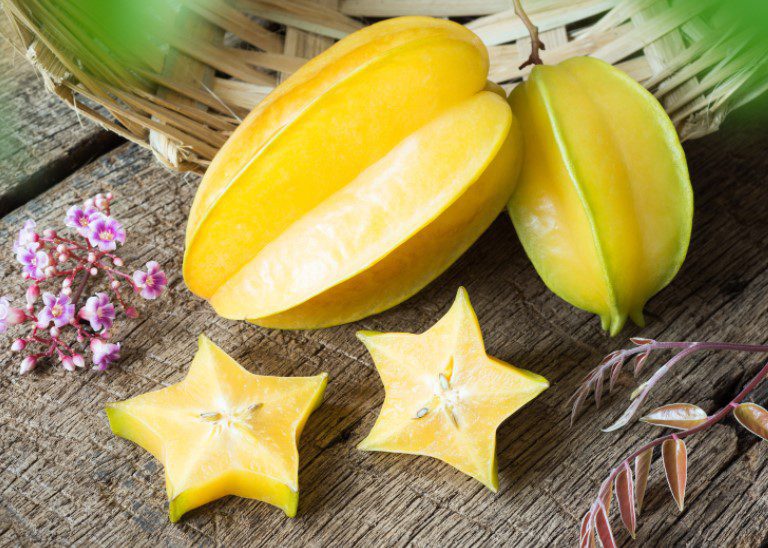Starfruit
Ay, carambola! Or, in plain English, “Hey, starfruit!” This golden, tropical fruit gets its name because, when sliced, each slice is shaped like a star. Commonly used as a snappy-looking garnish at fine restaurants, starfruit is now easier than ever to find at supermarkets. More affordable, too.
Originally from Indonesia, starfruit has been grown commercially in the United States for only about 10 years.
It came to Florida in the early 1900s and has been a backyard fruit. Mass marketing to {American} consumers didn’t start happening until the 1980s.
Starfruit grows in southern Florida and Hawaii, the two spots with the necessary warm, subtropical climate. Hurricane Andrew in 1992, so this year’s crop is excellent. The season begins in the late summer and runs until March.
When ripe, starfruit is deep, golden yellow. Its flesh stays moderately crisp, and it has flavors of apple and citrus, with a pleasing bright tartness. Plus, being a great source of vitamin C and contains only about 30 calories per half-cup.
The fruit has protruding ribs that are easily damaged and bruised — they’re what form the points of the “star” — but it also has a natural waxy exterior that’s edible and offers protection.
If you buy green, unripe starfruit, let it sit on the counter for a few days, it’s tropical, so it doesn’t like the cold. We don’t recommend refrigeration at home. Just keep it on the counter and eat it when it turns yellow.
Starfruit can be used the same way you’d use pineapple.
Anything you can do with pineapple, you can do with starfruit. You can eat it out of hand, and its shape makes it great for parties and relish trays. It makes a nice decoration.
Starfruit slices are nice and firm so that they can be split slightly and placed on a glass of iced tea or the edge of an ice cream dish, and they look beautiful floating in a punch bowl.
In her Fruit Cookbook, author Nicole Routhier calls starfruit a “stellar complement” to creamy cheeses, such as goat cheese. She finds it pairs nicely with chocolate and nuts, especially hazelnuts and macadamias.
To add to the main dish with meat, poultry, or seafood, Routhier suggests grilling starfruit to give it an appetizing smokiness. Cut the fruit into 1/2-inch slices, brush lightly with vegetable oil or honey — or both — and grill until golden, about two minutes per side.
Chefs often use starfruit as a decorative element in desserts—perch slices on the fruit bowl or place starfruit slices next to pastry servings.
Sweet or sour, carambola is a star in the fancy fruit department, looking to edge kiwi out of the limelight.
SAUTEED SHRIMP AND CARAMBOLA RECIPE
Serves 2
1 pound shrimp, preferably small
3 small carambolas, preferably medium-sweet, about 2 ounces each
21/2 tablespoons butter
Salt and white pepper to taste
Pinch sugar
1 tablespoon lemon juice
How To Prepare
Shell and devein shrimp. If they’re not small, halve lengthwise. Cut tips off the carambola, then slice 1/8-inch thick.
Heat 2 tablespoons butter in a large nonstick saute pan. Add shrimp, carambola slices, salt, pepper, and sugar.
Saute for a minute or two until the shrimp are pink. Add lemon juice and toss.
Remove from heat; stir in remaining butter: taste and season.
Serve at once.
How to grow starfruit in Containers
When growing starfruit in containers, it is important to remember that this tree requires high temperatures, at least 60°F (15 C) for flowering, and subsequent fruit set.
The tree will bloom all year if it has consistent temperatures and sunlight. There are many cultivars, but only two seem to thrive when they are grown in containers.
Maher Dwarf and Dwarf Hawaiian will flower and fruit for years in containers measuring 10 inches (25 cm). Maher Dwarf bears small to medium-sized fruits on a three-foot (1 m.) high tree.
The ‘Dwarf Hawaiian,’ however, bears more fruit than the previous. Although potted starfruit doesn’t care too much about the soil they are planted, they will bear more fruit in moderately acidic loam (pH 5.5 to 6.5) and grow faster.
The tree is sensitive and should not be overwatered. However, its root system is immune to many root diseases that affect other potted fruit trees.
Carambolas love full sun but can tolerate partial shade. A balanced fertilizer should be applied to container-grown starfruit trees from the spring to the fall. Organic granular fertilizers can be applied once every three months.
Slower-release fertilizers or organic granular fertilizers should be used. Iron chlorosis can occur in starfruit trees during winter. This is characterized by the interveinal yellowing of the young leaves.
You can either spray the tree with chelated Iron or wait until the weather warms up. Symptoms will usually resolve themselves.
Starfruit trees are relatively pest-free and will usually begin to bloom as soon as they reach 0.5m (or a foot and a half) in height. You may even be able to get some fruit.
You can shape and prune the flowers from older wood, which will not slow down fruit production.
To grow dwarf varieties in container gardening, you should trim the branches that reach the ground in late winter to allow spring growth spurts.























